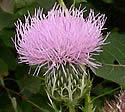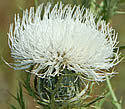Cirsium discolor (Field Thistle)
| Also known as: | Pasture Thistle |
|---|---|
| Genus: | Cirsium |
| Family: | Asteraceae (Aster) |
| Life cycle: | biennial |
| Origin: | native |
| Habitat: | sun; fields, along roads, open woods |
| Bloom season: | July - October |
| Plant height: | 3 to 7 feet |
| Wetland Indicator Status: | GP: FACU MW: FACU NCNE: UPL |
| MN county distribution (click map to enlarge): |  |
| National distribution (click map to enlarge): |  |
Pick an image for a larger view. See the glossary for icon descriptions.
Detailed Information
Flower: 

![[photo of flowers]](/udata/r9ndp23q/purple/cirsium-discolor-field-thistle_0816_170321-t.jpg) Flower head is 1½ to 2 inches across, pink to lavender, or occasionally white. Several to many flower heads branch off the main stem in the upper part of the plant. The bracts are flat, green with a white stripe and resemble fish scales. Each bract has a ¼ inch long needle-like spine at the tip that sticks straight out.
Flower head is 1½ to 2 inches across, pink to lavender, or occasionally white. Several to many flower heads branch off the main stem in the upper part of the plant. The bracts are flat, green with a white stripe and resemble fish scales. Each bract has a ¼ inch long needle-like spine at the tip that sticks straight out.
Leaves and stem: 


![[photo of leaves]](/udata/r9ndp23q/pd/cirsium-discolor-26-t.jpg) Leaves are up to 9 inches long and 3 inches wide, divided into several narrow lobes, some divided further, with small spines all along the edges and longer spines at the lobe tips.
Leaves are up to 9 inches long and 3 inches wide, divided into several narrow lobes, some divided further, with small spines all along the edges and longer spines at the lobe tips.
![[photo of leaf underside]](/udata/r9ndp23q/purple/cirsium-discolor-field-thistle_0814_171600-t.jpg) The underside of leaves is white, covered in short hairs. Stems are also covered in hairs, but are not spiny, and often heavily branched in the upper plant.
The underside of leaves is white, covered in short hairs. Stems are also covered in hairs, but are not spiny, and often heavily branched in the upper plant.
Notes:
Field Thistle most closely resembles Tall Thistle (Cirsium altissimum), which also has soft needle-like spines on the floral bracts, hairy stems and white on the underside of leaves. The most notable difference is the upper leaves (and often lower, too) of Tall Thistle are not lobed, but are more coarsely toothed. The non-native thistles are distinguished by their sharp spines, especially along the stems. While most references give a height of Field Thistle up to 7 feet, we've seen plants rather taller.
Native Plant Nurseries, Restoration and Landscaping Services ↓
More photos
Photos by K. Chayka taken at Long Lake and Rice Creek Regional Parks, Ramsey County. Other photos courtesy Peter M. Dziuk.
Comments
Have you seen this plant in Minnesota, or have any other comments about it?
on: 2014-07-03 03:08:14
It cropped up on the edge of our lawn near some shrubs in an area that in the past was mowed but I've decided to let grow mostly wild now. I already thought that this thistle looked cool and was inclined to leave it be and knowing now that it is native I'm even more inclined to just let it grow. It is now early July and no flowers have shown up yet so I have its blooming to look forward to also.
on: 2017-07-03 15:35:56
This plant grows in a few spots just off the Munger Trail near HWY 61 in Atkinson Township. It was there long before the old RR grade was turned into a trail. And today, I found a plant in bud growing in an old field behind my house. Not 100% positive on that one's id but in a week or so it should be in flower. Everything else points to C. discolor, though.
on: 2018-08-20 18:37:08
I have quite a few growing on my wooded property in the Minnetonka Mills area. Purple flowers, 7 feet tall.
on: 2019-05-08 19:32:50
Does this plant spread by underground roots similar to the sprouts on a potato? I have been digging them out where we are removing buckthorn and honeysuckle to make room for oak savanna restoration. I hope I will not have to walk through a field of thistles. Now I see that they are native. :-( I still don't like them!
on: 2019-05-08 19:51:21
Helen, most thistles are biennial, not perennial, emerging from seed every 2 years (the invasive Canada thistle is the exception). The first year is a basal rosette, the second year the flowering stem bolts, then the plant dies after setting seed. So they do not spread by roots but there may be a large seed bank to contend with.
BTW, native thistles such as field thistle are great pollinator plants, attracting bees, beetles, flies and butterflies, not to mention birds such as gold finches. And the native thistles don't have very sharp spines like the invasive ones do. Don't knock it.
on: 2021-07-14 14:34:33
We have many field thistle in an oak savanna area in Washington County that we are restoring. It is a beautiful plant! The photo you have on this website shows just how large they can be - tree-like.
on: 2021-07-16 10:52:18
This beauty caught my eye with it's striking white flower. It is growing next to a gravel driveway.
on: 2021-08-18 17:30:53
One of our neighbors has tons of this growing in an old field, and it's in full bloom now. It's absolutely gorgeous, and constantly covered in numerous bees, butterflies, wasps, flies, beetles, ants, and all sorts of other pollinating animals. They also attract a huge amount of birds in fall. I'm currently restoring a patch of native prairie in our yard, and I definitely plan to grab a few seeds from the neighbor's house and add this plant to the mix. I've always been fond of most thistles (not Canada thistles though, those are absolutely evil), but this has to be one of my absolute favorites.
on: 2021-08-19 09:04:02
Peter, just be certain your neighbor does not have one of the non-native thistles first. Field thistle is easy to tell from the white undersides of its leaves.
on: 2021-08-20 00:12:41
Yep, I triple checked before my previous comment! They?re a really nice plant. Thanks for the information!
on: 2022-08-06 09:30:38
Does Canada thistle have thorny/spiny stems? I am seeing some conflicting information on this site.
on: 2022-08-06 12:29:34
Stacey, Canada thistle has sharp spines like other non-native thistles. However, its stems are merely hairy, not spiny like the others.
on: 2022-08-11 14:50:42
I dont know what this thing is, but I took pictures and it is 9 feet tall. Pollinators love it! Not letting any seeds go just in case its evil







 a robust Field Thistle plant
a robust Field Thistle plant more flowers
more flowers Field Thistle with white flowers
Field Thistle with white flowers more plants
more plants